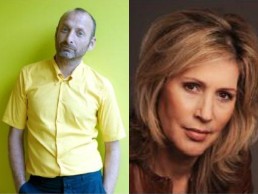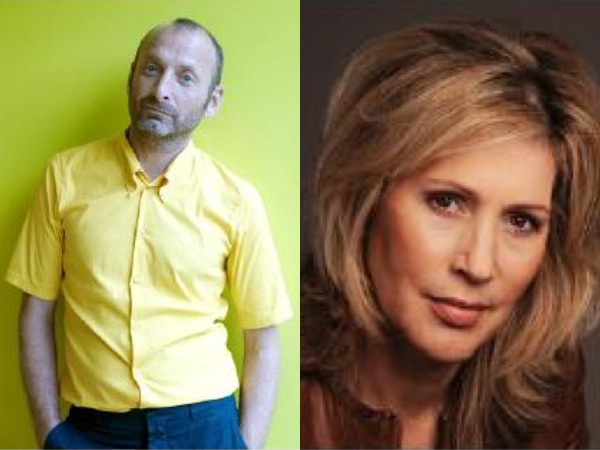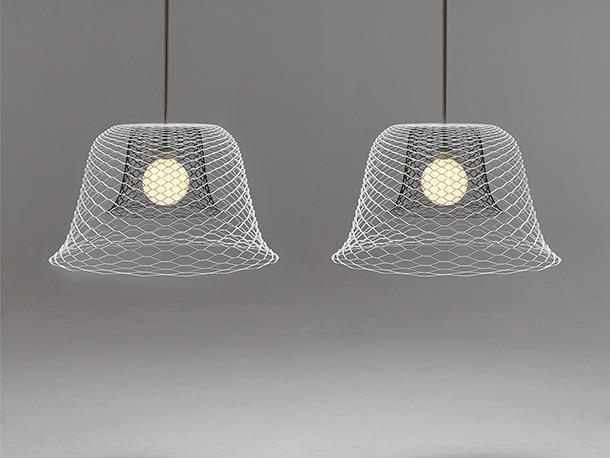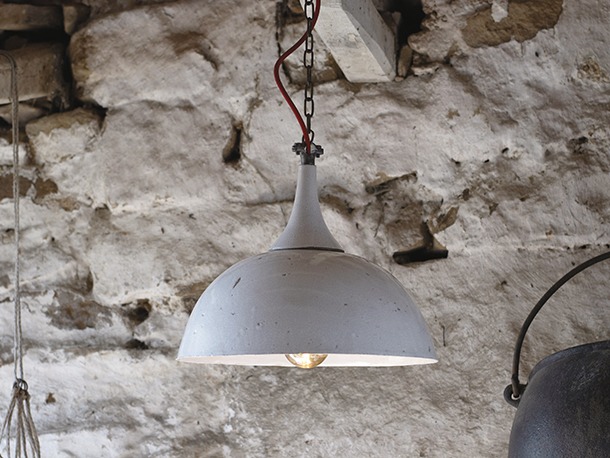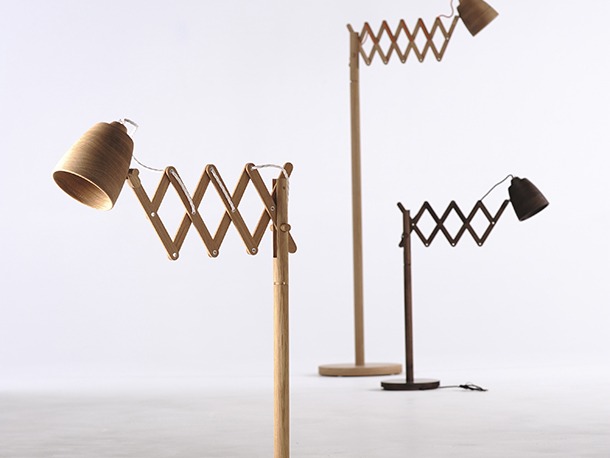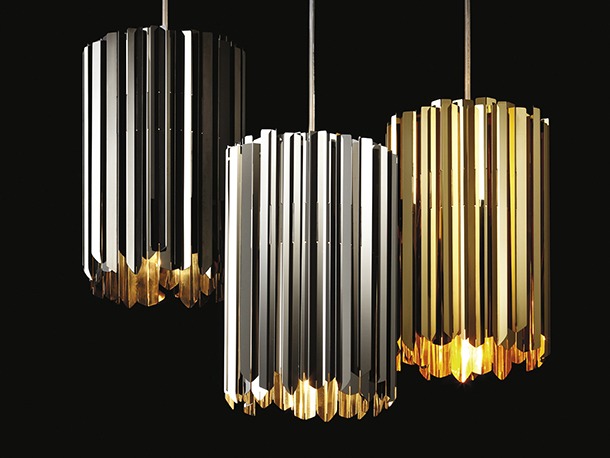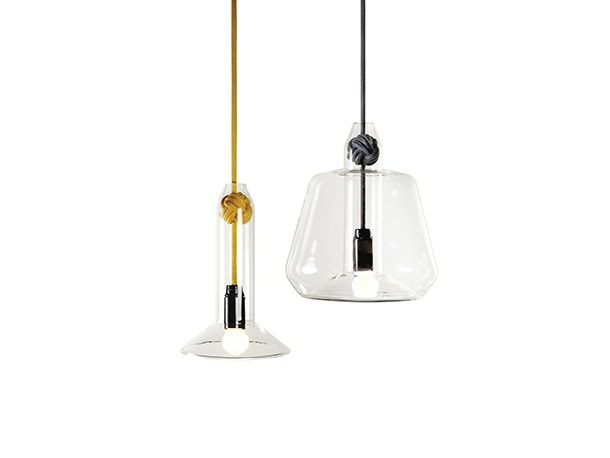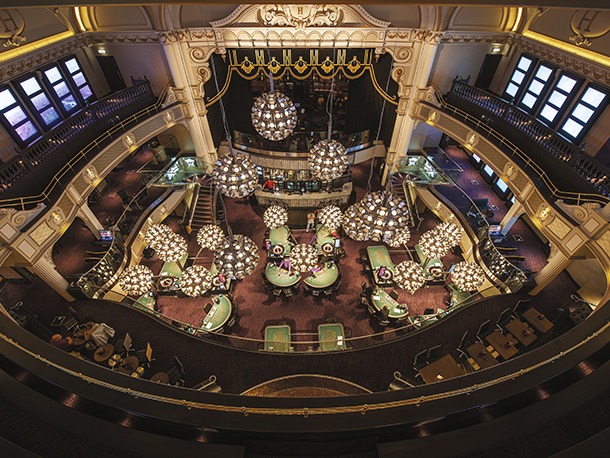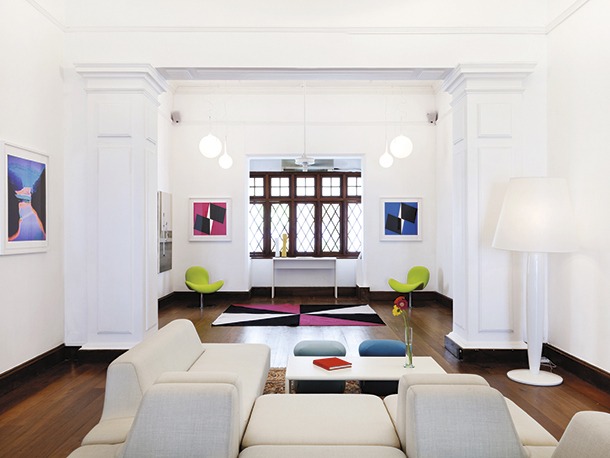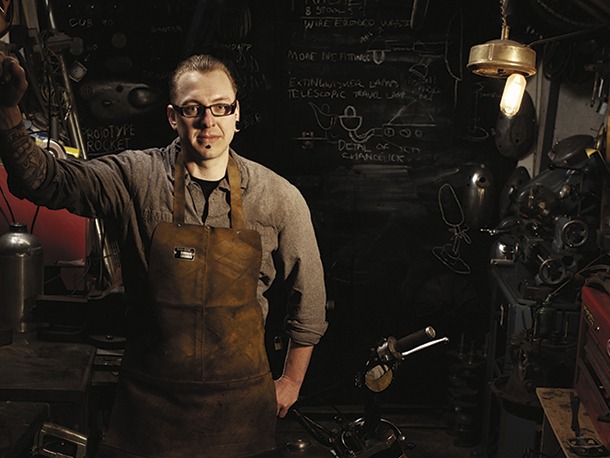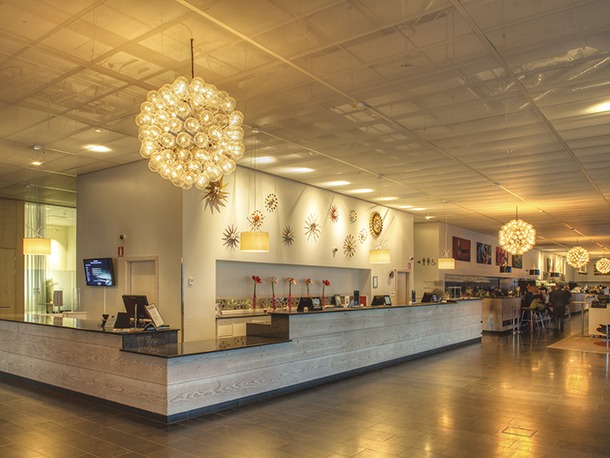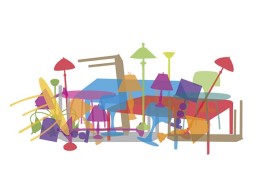Ab Rogers and Vanessa Brady lend creative talent to May Design Series.
Renowned designer Ab Rogers and interior design industry leader Vanessa Brady will be lending their creative talents to the May Design Series 2013 - a new, intelligent, commercially focused event for the A&D and high-end retail community.
Rogers, whose vivid designs and unique concepts can be found throughout the Tate Modern, Pompidou Centre and the Science Museum, has been hand-picked to design a totally unique trade show experience that will take visitors on a journey through a ‘city-scape’ environment. The May Design Series is comprised of four shows – The ARC Show, kkb, Interiors and DX – and each of these will form their own district while also worked together to create one coherent experience. By playing with off-set footprints and exaggerated perspectives and planes, Ab’s designs promise ‘to create moments of drama, capturing and engaging the visitor’s attention’.
“The May Design Series will offer a totally different experience from a typical trade show environment,” Rogers reveals. “Our design is inspired by the city, a complex collection of streets and avenues punctuated by landmarks in the form of bars, innovation centres and lecture theatres. These will serve as hubs where visitors can congregate, learn, converse and be inspired by design and all that the May Design Series has to offer. We will exploit the areas above the stand, projecting up into the space and suspending structures within this void. Our ambition is to create a network of generous, sociable and communal spaces to encourage learning, play and rest.”
President and Founder of the Society of British Interior Design (SBID), Vanessa Brady has been brought on board for her acute industry knowledge and design expertise. The only London-based event to be supported by SBID, The May Design Series was selected by Vanessa for the high calibre of business providers and visitors from around the world the show is guaranteed to attract. Having previously worked together on the shows EcoBuild, Sleep and kbb Birmingham, SBID and the May Design Series form a natural partnership, promoting interior design through both the professional, retail and contract sectors.
Vanessa Brady comments: “For decades London has been perceived as the global destination of design. Where other cities have successfully created 'must attend events' we have yet to establish a world class show for the design industry. The May Design Series has addressed that gap in the market, creating a platform to showcase design on a world stage as the pinnacle of Britain's interior design industry. The stage is set and the world will be watching, visiting and buying at this long awaited and much anticipated destination.”
The May Design Series includes the newly launched INTERIORS LDN and DX and the established ARC Show and kbb LDN. The event will take place at London ExCeL, May 19-21 2013.
www.maydesignseries.com
Slingerlamp
Slingerlamp, originally launched in Milan, is the latest design by Richard Hutten, better known for his playful concepts ‘No sign of design’ and ‘Table upon table’. Its shape is intended to “evoke the sensation of a party” with a particular focus on the of restaurant spaces .
The Slingerlamp is made in Holland at NgispeN’s own factory using the latest in laser cutting technologies. It comes in a variety of colours.
Laerdal
Laerdal’s clean Scandinavian inspired lines provide subtle, flattering soft light. Aditi’s trademark volcanic basalt like exterior hides a deeply glazed white and lusciously textured interior, that serves to bounce and scatter soft light around the inside of the 16 inch diameter bowl.
Finnieston Lamp
The Finnieston Lamp from designer Samuel Chan features an accordion neck that extends and rotates - a familiar mechanism given new charm by being handcrafted in wood. The lamp shade, too is solid wood – a development made possible by the very latest LED technology.
Facet Pendant
The Facet Pendant is the latest addition to the Facet family. Available as a stand alone fitting, it can also be used to great effect in multiples to create larger feature installations. The piece - designed by Tom Kirk Lighting - is available in polished stainless steel, black nickel and gold.
Knot Lamps
Knot Lamps come in two different designs of hand blown glass shade each supported by a monkey fist knot. The knots are tied in the brightly coloured cable - available in five colour options. These wedge in the narrowing inner neck of the glass shade to hold everything in place.
Float Floor Light
The Float Floor light has a movable paper shade that can float to any position along its vertical wooden spine. Adjustment is simple, with a rubber band used to keep the head in place. 1800mm high and with a 600mm diameter shade, the float is powered by dimmable LED.
Hippodrome Casino, UK
The launch of the palatial Hippodrome Casino on Leicester Square, right in the heart of London’s tourist district, ushers in what CEO and co-founder Simon Thomas believes will be a new era in British gaming.
“We will challenge the long-held conceptions of casinos in the UK as either too expensive for the normal man on the street, or tucked away in back alleys in the wrong part of town,” Thomas declared. “In fact we’re determined to not only challenge them, but redefine the way in which visitors to the West End celebrate an evening out.”
It’s a bold vision, but one made possible by recent changes to the country’s Gaming Act that allow venues to offer food, drink and live entertainment under one roof for the first time. The adoption of the former Hippodrome Theatre fits perfectly with this desire to create a high profile, inclusive entertainment experience. Originally opened in 1900, it followed designs by the renowned theatre architect Frank Matcham and initially operated as a circus variety theatre featuring swimming polar bears and acrobats who dove into pools from the fourth floor balcony. Later incarnations as live variety theatres and nightclubs all left their mark on the building, and these layers had to be stripped away before a whole-scale restoration of the site could begin.
The aim was to return the interior to its original glory. Following plans by architects Cadmium Design, the space was split into cocktail bars, restaurants, lounges, casino gaming floor, poker deck, VIP gaming, salle privee rooms, a cabaret room and a smoking terrace.
Lighting designers Into were brought in to illuminate the space in a way that would reflect the history and grandeur of the building. Key to the brief was the need for low maintenance and energy efficient lighting that could endure 24-hour use. Appropriate lux levels were required to provide a shadow- and glare-free gaming experience for players, whilst providing the necessary light levels for security cameras to closely monitor play.
LED lighting forms the majority of the general lighting. LED downlights from Lucent were used with a deep baffle to minimize glare to gaming tables. LED cove and concealed lighting from UK LED was used to illuminate key interior design features - coffers, bottle steps, bar nosing etc - whilst providing subtle ambient illumination to circulation areas. For the theatrical elements within the Cabaret VIP areas, care was taken to produce a subtle design that would evoke an exclusive five star customer experience.
Decorative lighting elements provide a final layer of opulence to the space. The entrance hall sets the tone for the entire venue with a series of Bead chandeliers from Innermost that deliver a golden metallic glow to the surrounding space. Inside the main room, rows of clear spherical fixtures hang from reclaimed pulleys running above the balcony areas that now house the bars and dining areas. Dubbed Crystal Rain, these pieces reference both the venue’s theatrical glamour and notions of Britishness – namely a stoic relationship to the occasional downpour.
The bar front in the main room is created using fibre optics that feed a multitude of crystal heads. Each head is set in its own individual tray with edges that catch the splay of light and shadow from the crystals. Above the first floor bar, Artemide LED Net Circle fixtures hang from the ceiling and are repeated in the surrounding mirrored surfaces.
All of the interior feature luminaires were installed with energy efficient Osram Energy Saver Halogen lamps. Halogen was chosen for its colour rendering properties and warmth of the lamps when dimmed.
Undoubtedly the venue’s lighting showstoppers are found in the main casino room where giant ‘dandelion clock’ lighting pieces provide a mix of fantasy and glamour. These bespoke pieces were constructed by Mike Stoane Lighting following a concept by Cadmium MD Paula Reason. They were inspired in part by an 1899 Daily News article about the reaction of the first visitors to the newly opened Hippodrome: “They walked around the new building astonished, puzzled and delighted, like Alice in Wonderland,” it reads. “Every now and then they had almost to pinch themselves to make sure they were awake.”
In addition to adding drama, the pieces also had to fulfill a variety of other functions, such as housing CCTV cameras, audio speakers and of course providing increased light levels to the gaming tables. Most of the spherical heads are mounted on curved armatures that are anchored into the ground between the gaming tables. By bracing them together in this way, stability is increased and movement is avoided – essential for the capturing of clear security footage. In addition to these, several individual pieces are suspended at different heights within the vast room, as if blown from their metal stems by a summer breeze. Their presence draws the eye up, prompting guests to admire the height and elegance of the space.
Each spherical head is constructed from clusters of individual lamp heads with simplified barn door fronts - manufactured to mimic traditional theatre par cans. These are attached in an array around a central ball. Though identical in appearance, the cans are fitted with either Cree LED lamps or LED AR111 replacement lamps, the latter used to provide brighter illumination for the tables. Where necessary, these par cans and their barn door fronts were designed to allow a degree of adjustment to enable the light to be precisely aimed.
www.cadmiumdesign.co.uk
www.into.co.uk
Norwegian Official Residences, Norway
It’s easy to overlook the importance of a nation’s overseas emissaries. Though most ambassadors only come to public attention during times of intergovernmental tensions – recalled or expelled as an expression of political will – their true worth is far subtler. In addition to providing a smooth conduit for political discourse, they play a vital role in developing and promoting a national brand. The benefits of this come not only as tangible increases in global trade, but also in the development of so-called ‘soft power’ – the use of national cultural identity to improve sway in the international political and business spheres. As a venue for meeting and entertaining, the ambassador’s residence plays an important part in this process. No one knows this better than the Norwegian Government who have undertaken a program of improvements to turn their official residences into cultural outpost that immerse guests in the very best of Norway’s homegrown craft and design.
In 2009, the Royal Norwegian Ministry of Foreign Affairs awarded a two-year tender to Norwegian interior design agency Dis, contacting them to undertake a series of projects in government spaces around the world. Such was their success in the role that the Ministry has since extended the agreement into 2012.
Dis’s work began with the Official Residence in Colombo, Sri Lanka. The team of two, Solveig Baalsrud Svoor and Ine Bangås Johansen, were given a very open brief on the project. “We had never worked with an official residence, and the client wanted to use this as an advantage and not put too many constraints on us, so we would be able to see it with new eyes,” says Baalsrud Svoor. The one proviso was that the majority of the furniture, lighting and other essential elements should in some way promote Norwegian design.
Their approach was to preserve the building’s traditional character but contrast this with feature pieces that expressed Nordic tastes. Colours were chosen that would emphasise the Scandanavian designs, but were at the same time inspired by Sri Lankan traditional clothing and their rich natural landscape. General lighting was provided locally, but Dis had the task of choosing feature lighting that could be used to create different moods within the different rooms of the residence.
Some of the lamps - such as the Big Mama from Northern Lighting, located in the living room - add an element of humour to the space. A large floor lamp, Big Mama is made out of paper and wood, considered appropriately basic and eco-friendly ‘Nordic materials’ by the Dis team. An illuminated moose head wall light - Moo, designed by Trond Svendgårdh and Ove Rogne – hangs in the dining room like a kitsch hunting trophy. As well as being a clever conversation starter, the piece works well with Camouflage, the pendant that hangs above the dining table. This piece throws out a scattered pattern of light and shadow reminiscent of the Norwegian forests that make up the moose’s natural habitat.
Snow white drops of Artemide Castor pendants hang in the hallway while the lunch/meeting room is given a splash of colourful stripes thanks to Zero’s PXL pendant. In the library-cum-office a cluster of Established & Sons Torch pendants - PVC dipped polymer cones with clear, diamond textured polycarbonate diffusers – provide top lighting whilst a Luxo L1 desk light adds a classic touch. More recently, the Dis team completed another residence, this time in Tallinn, Estonia. The design philosophy remained the same, though with a different climate and cultural location the end result was stylistically specific to host the city. Some pieces used in Sri Lanka make a reappearance: the Big Mama standard lamp stands guard in the living room this time joined by Northern Light’s Bender, a big-headed floor/reading lamp with a thin metal stand that coils up from the floor like a length of kinked rope. Modernica’s reissue of the Saucer Pendant- part of George Nelson’s 1950s bubble lamp series – hang from the room’s existing ceiling roses.
In the hallway, three glazed-porcelein Bell pendants hang with cables intertwined. The muted tones of their exterior, inspired by the rocks and plants of Scandinavia, contrast elegantly with the pure white of their inner surface. Berg wall and pendant lights in the dining room supply obvious symbolic links to Norway’s ice fields while above the dining table hangs a Hope pendant. Part of Luceplan’s collection, Hope has polycarbonate petals formed by Fresnel lenses that optimise reflection and refraction to scatter thousands of ‘icy’ shards of light across the space.
www.dis.no
The Rag & Bone Man
It takes a second to become accustomed to the scene that waits inside Paul Firbank’s Hackney workshop, a few moments to distinguish tools from materials; scrap components from works-in-progress. But then, as the brain adjusts, intriguing forms begin to pull in to focus: a wall lamp made from motorbike parts; a stool formed from a tractor seat – a host of furniture and fittings created from elements that once served a completely different purpose.
This is the home of The Rag & Bone Man, the company established by Firbank just one year ago as a brand for his unique range of reconstituted pieces. Much like the scrap he acquires on his regular trawl through the junk-yards and grease-shops of East London, the Rag & Bone Man moniker has been adopted and repurposed for a contemporary age. Whilst his 19th century predecessors merely bought and sold waste as raw materials for others to process, Firbank is very much a craftsman, embracing 21st century ideals of reuse and recycling to produce items that seem totally fresh, but at the same time have an antiqued, vintage quality.
The success of the pieces is largely down to Firbank’s ability to identify the innate beauty of quality engineering – found even in the most functional of parts. It’s a talent that suggests he has truly found his calling after a circuitous career path through an array of occupations – from tattoo artist to metal engineer and welder – eventually leading him back to his native Hackney where, in 2011, he set up the Rag & Bone Man alongside partner Lizzie Gossling.
“I started to make sculptures and lamps from found/scrap materials in my spare time,” explains Firbank. “The lamps would always generate most interest and lead to most of my sales and commissions so I decided to focus on these to see what their potential was. My first major show and launch was at Tent London 2011 where I had an overwhelming response and sold everything I had to exhibit in the first three days, giving me the confidence to go full time.”
The Rag & Bone Man returned to Tent this September after a hugely successful first year in business. On show were the workshop’s latest pieces, including a glorious chandelier, based around an old aeroplane rotary engine. Stripped down and thoroughly cleaned (using a local drive-through carwash, much to the bemusement of the garage attendants), this central body section is embellished with lamp heads created from old fire extinguisher shells. The chandelier is earmarked for the lobby of a new hotel development, the first of what Firbank hopes will become a series of commissions for large scale projects.
The engine’s second life, however, is spread further than an individual lighting fixture. As with many donor machines, different sections will eventually contribute to a variety of other works. The engine vent casing, for example, may become part of a chair, the back panel could end up as the surround for a wall clock. The continuous process of development means that the final nature of a piece will remain in flux until its completion, or until a perfect part can be found to complement a work in progress.
As word of his work spreads, Firbank’s search for materials has become ever easier, with members of the public contacting him directly to offer unusual bits of scrap. And over time, as his ability to mentally carve up existing machines in to new forms develops, the wealth of future possibilities looks ever more appealing.
Scandic Victoria Tower Hotel, Sweden
The new Victoria Tower Hotel incorporates high quality design at every level, including a collaborative first between Flos and Megaman that delivers both style and efficiency.
Standing at 118 metres tall the new Scandic Victoria Tower is a sparkling addition to the Stockholm skyline. Located in Kista, a district to the north of the city, the hotel boasts 299 rooms across 34 floors, making it the tallest not only in Sweden, but also across all of Scandinavia.
The tower has received much critical acclaim for its attention to high quality design at all scales, from the stylish exterior scheme right down to the individual visitor experience.
Architect Gert Wingårdh took inspiration from a sequin evening dress when creating the building. The triangular planes of its glass and steel façade reflect the sky and sunlight to produce a shimmering surface. Windows follow the triangular grid, resulting in an equally intriguing pattern of illumination at night. The unusual fenestration also creates refreshingly individual interiors, allowing angular blocks of daylight to enter each room in a way that constantly reminds guests of the hotel’s structural aesthetic.
Construction of Victoria Tower was driven by Norwegian investor Arthur Buchardt, who wanted the highest standard of finish for the hotel. He selected Flos fixtures for both private rooms and public spaces and, to ensure efficient, cost effective and environmentally friendly operation, these were twinned with Megaman lamp technology - a collaborative first for the two brands. Throughout the hotel’s corridors and other public spaces, 900 bespoke luminaires, including both downlighters and wall fittings, have been designed to include Megaman’s LED Par16 7W GU10 reflectors, with 35 degree beam angle delivering 600 cd beam power, and Megaman’s Liliput Plus 23W E27 CFLs.
Flos’ Easy Kap Fixed downlighters, for example, run throughout the hotel’s corridors. These fit flush to the ceiling giving a smooth, understated and natural look, aided by the LED Par16 7W GU10 lamps. Along the corridor walls, Flos’s Soft Spin fixtures sit plastered into the hotel structure to illuminate individual room numbers.
Inside the rooms, Flos’s classic Arco lamps are used to add a designer chic, while Philippe Starck-designed Ktribe floor and wall lights – fitted with Liliput Plus CFLs - add to the room’s warm ambiance.
Flos’ Mini Glo Ball luminaires, part of a range designed by Jasper Morrison, are installed around all of the hotel’s 300 bathroom mirrors. Made from white Murano glass to give off a soft white light, each is fitted with Megaman’s GU9 Series of 7W CFLs.
In the public spaces, the decorative pieces are bigger and bolder in character. Both the Lobby bar and 34th floor Skybar feature Taraxacum pendants - bubbly explosions of light designed by Achille Castiglioni. The reception area is illuminated by Rodolfo Dordoni’s Ray-S pendants and Skygarden by Marcel Wanders hang above the lobby lounge.
Whilst all the Flos fittings used ensure a high quality look, it is the lamp technology that ensures their sustainability with an estimated saving of over €300,000 and 175,000kg CO2 over the lifespan of the lighting installation.
www.flos.com
www.megamanlighting.com
Designed for Disposal
“Planned obsolescence... companies deliberately design products with a limited life, so you have to buy the same thing again.”
This is an excerpt from a video by Vitsoe, a design driven furniture company that has the ethos ‘Living better, with less, that lasts longer’.
It is in our human psychology to have the desire to own products that are new, different, more in the style of the moment and just a little bit newer. It is the ethos of the marketing and sales departments at most companies. It might even be the ethos for company objectives in general. Obsolescence plays into a human psychological ‘weakness’ and companies are very good at making use of it in order to sell more products. These are new products we don’t really need and are not genuinely better than the ‘old’ products we are replacing. Short time satisfaction that leaves us with a lot of stuff we don’t need or should have. It simply leaves us with a lot of waste. Far from being sustainable, I might add.
The problem is that planned obsolescence works so well in selling more products. It enables companies to do the single most important thing on their agenda: sell more products, and thus generate higher profits.
A clear example is IKEA. We all know them, and many of us buy products from them. Their products are relatively cheap, come in many (style) options and every year or so there is a new collection. This time just a little newer, different looking, more shiny and with a funky new colour. It is the same principle of planned obsolescence. IKEA themselves call it; ‘democratic design’ or ‘design for everyone’. “While keeping great quality,” they add.
There are a few problems with all of this. The first being dishonesty. They use the word ‘design’ to add so called value. In reality, they just add to the inflation of the word design. That does not have anything to do with good design. They call it democratic, because they sell products for a price many can afford. While that may be true to some degree, as a designer I believe this to be totally the wrong approach. Good design needs to be about better products that, as Vitsoe says, ‘last longer’. In other words, it needs to be sustainable. IKEA products are very attainable at its low retail price. To say it has high quality is just dishonest. It simply isn’t top quality. It is made of low quality materials. It is so simplistic we as ‘consumers’ can even assemble it. Most will say all of that does not matter as they want to buy new versions in one, three or maybe five years anyway. And that makes sense. At that moment it is either broken, damaged or consumers are simply tired of the look and feel of it. So we go back to IKEA and buy new stuff; planned obsolescence. All the ‘old stuff’ ends up on top of the big pile of waste. But most consumers don’t really notice that so don’t care, right?
The whole design and business approach of IKEA (and many others) is one of non-sustainability, wastefulness, fashionable and superficial aims. It has nothing to do with simplicity but everything with simplistic.
The big problem lies within the focus of most of these companies. Design for them is so often about sales opportunities, marketing objectives, competitiveness and doing something new that is in the latest style. The design of so many products is determined by profitability in the short term. Knowing people will get bored or fed up with the ‘obtrusiveness’ of the product and so throw it away and buy a new version, as explained in the IKEA example above.
A good designer’s first duty is to the user and understanding their needs, wants, use and even emotions. Design should be user-orientated. Companies should take the risk and do something that is genuinely new and better. Don’t tell everyone products are innovative just to sell them. Instead work hard and make sure they really are innovative. After all, if they truly are you don’t have to say it that much. People know they are. Good design takes time, a lot of effort, craftsmanship, focus and a mix of trial and error. Because of this, it can never report to a marketing plan, time constraint or budget. They all matter, but always as part of the design process, never the other way around.
As Dieter Rams once said, “Simplicity is the stripping away of all that is unnecessary.” What I’m saying is for all companies out there, and those most definitely include lighting companies of course, the “stripping away of all that is unnecessary” does not only have value with designing products. It should apply to companies and how they operate as well. Steve Jobs described this well for the big companies with leading market positions, in an interview he did when he said;
“When a company has a monopoly position, sales and marketing people run the company, not product people. If that company would make a better product, it doesn’t matter. The company is not going to be more successful considering them already having the monopoly position. It is the sales and marketing people who can make the company more successful. The product people get driven out of decision making forums and the companies forget what it means to make great products. The product genius or sensibility that brought the company to the monopoly position get rotted out by the people that have no conception of the difference between good or bad products.”1
Sadly, I believe the above doesn’t only happen with companies that have a monopoly position, but also others as they try to be more successful and make more money. If we really want to be innovative and come up with better products within the lighting industry (and outside for that matter) we really need to shift our goals and focus.
If companies are really as sustainable as they say they are, then they need to have fewer products that are better designed and thus longer lasting. But as of now, most companies use ‘sustainability’ as an empty marketing tool for branding. The companies that take sustainability seriously and are authentic about it are almost as scarce as the number of companies who take design really seriously.
I’m saying the things that most companies might not want to hear or take action upon, just like our parents used to do when we were children. And just like we knew as children, the people making up all those companies know we need to make the change. It is just hard to do.
Citations: 1 - Steve Jobs: The Lost Interview (2011)
Thomas Wensma is founder of Ambassador Design.
info@thomaswensma.nl
twitter.com/thomaswensma


